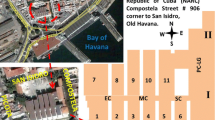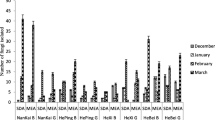Abstract
The composition of fungal biota and air quality of five traditional subterranean wine cellars and one store building of a modern wine production facility were examined in the Tokaj wine region (northeastern Hungary). Air samples were collected with SAS IAQ sampler onto PDA, MEA and RBA. Strains representing morphotypes were isolated from colonies formed on agar plates from either air or surface samples. The internal transcribed spacer (ITS) region of the rRNA gene cluster was amplified with primers ITS1 and ITS4. Altogether 90 morphotypes were isolated, 48 and 12 strains (43 species) from the air and surfaces, respectively. The number of spore-forming species generated high diversity of indoor fungi and differences between the cellars’ fungal compositions; however, their dominant species were proved to be the same. Among the isolated strains Penicillium spp. were the most frequent. The walls of cellars were covered by colonies of Zasmidium (Cladosporium) cellare often referred to as a noble mold. Even so, this mold has been found only at a small concentration in the air samples (10–30 CFU/m3). The walls of the modern store were free of molds. Diversity of fungi of the examined wine cellars was influenced by environmental conditions to a certain degree, such as elevation (height above sea level), age, reconstruction time of cellars, indoor ethanol concentration and the number of chimneys. The location of cellars poorly influenced the concentration of fungi of the air inside cellars, contrary to outdoors where the air of the municipal area contained more CFUs than that of rural spaces.





Similar content being viewed by others
References
Askew, D. J., & Laing, M. D. (1993). An adapted selective medium for the quantitative isolation of Trichoderma species. Plant Pathology, 42(5), 686–690.
Boatto, V., Defrancesco, E., & Trestini, S. (2011). The price premium for wine quality signals: does retailers’ information provision matter? British Food Journal, 113(4–5), 669–679.
Cañas, I., & Ocaña, S. M. (2005). Study of the thermal behaviour of traditional wine cellars: the case of the area of “Tierras Sorianas del Cid” (Spain). Renewable Energy, 30(1), 43–55.
Clemenz, A., Sterflinger, K., Kneifel, W., & Mandl, K. (2008). Airborne fungal microflora of selected types of wine-cellars in Austria. Mitteilungen Klosterneuburg, 58, 17–22.
Day, J. H., & Ellis, A. K. (2001). Allergenic microorganisms and hypersensitivity. In B. Flannigan, R. A. Samson, & J. D. Miller (Eds.), Microorganisms in Home and Indoor Work Environments. Diversity, Health Impacts, Investigation and Control. Boca Raton, London, New York: CRC Press, Taylor & Francis Group.
Douwes, J., Thorne, P., Pearce, N., & Heederik, D. (2003). Bioaerosol health effects and exposure assessment: progress and prospects. Annals of Occupational Hygiene, 47, 187–200.
Ewaze, J. O., Summerbell, R. C., & Scott, J. A. (2008). Ethanol physiology in the warehouse-staining fungus. Baudoinia compniacensis. Mycological Research, 112(11), 1373–1380.
Fiedler, K., Schütz, E., & Geh, S. (2001). Detection of microbial volatile organic compounds (MVOCs) produced by moulds on various materials. International Journal of Hygiene and Environmental Health, 204(2–3), 111–121.
Flannigan, B., Samson, R. A., & Miller, J. D. (2011). Microorganisms in home and indoor work environments. Diversity, health impacts, investigation and control (2nd ed.). Boca Raton, London, New York: CRC Press, Taylor & Francis Group.
Fung, F., & Hughson, W. G. (2003). Health effects of indoor fungal bioaerosol exposure. Applied Occupational and Environmental Hygiene, 18(7), 535–544.
Gašinec, J., Rákay, Š., Rákay, Š., & Šimčak, M. (2012). Geodetic survey of tuff wine cellars in Vel’ka Tŕňa. Acta Montanistica Slovaca, 17(3), 189–194.
Goodwin, S. B., McCorison, C. B., Cavaletto, J. R., Culley, D. E., LaButti, K., Baker, S. E., et al. (2016). The mitochondrial genome of the ethanol-metabolizing, wine cellar mold Zasmidium cellare is the smallest for a filamentous ascomycete. Fungal Biology, 120(8), 961–974.
Goto, S., Takayama, K., & Shinohara, T. (1989). Occurence of molds in wine storage cellars. Journal of Fermentation and Bioengineering, 68(4), 230–232.
Haas, D., Galler, H., Habib, J., Melkes, A., Schlacher, R., Buzina, W., et al. (2010). Concentrations of viable airborne fungal spores and trichloroanisole in wine cellars. International Journal of Food Microbiology, 144(1), 126–132.
Klich, M. A. (2002). Identification of common Aspergillus species. Utrecht: Centraalbureau voor Schimmelcultures.
La Guerche, S., Chamont, S., Blancard, D., Dubourdieu, D., & Darriet, P. (2005). Origin of (−)-geosmin on grapes: on the complementary action of two fungi, Botrytis cinerea and Penicillium expansum. Antonie van Leeuwenhoek, 88(2), 131–139.
Macher, J. M. (1989). Positive-hole correction of multiple-jet impactors for collecting viable microorganisms. The American Industrial Hygiene Association Journal, 50(11), 561–568.
Magyar, I., & Bene, Z. (2006). Morphological and taxonomic study on mycobiota of noble rotted grapes in the Tokaj wine district. Acta Alimentaria, 35(2), 237–246.
Magyar, D., Eszéki, E. R., Oros, G., Szécsi, Á., Kredics, L., Hatvani, L., et al. (2011). The air spora of an orchid greenhouse. Aerobiologia, 27(2), 121–134.
Magyar, D., & Oros, G. (2012). Application of the Principal Component Analysis to disclose factors influencing on the composition of fungal consortia deteriorating remained fruit stalks on sour cherry trees. In P. Sanguansat (Ed.), Principal Component Analysis - Multidisciplinary Applications (pp. 89–110). Rijeka: InTech.
Magyar, I., & Tóth, T. (2011). Comparative evaluation of some oenological properties in wine strains of Candida stellata, Candida zemplinina, Saccharomyces uvarum and Saccharomyces cerevisiae. Food Microbiology, 28(1), 94–100.
Magyar, D., Vass, M., & Li, D. W. (2016). Dispersal strategies of microfungi. In Biology of Microfungi (pp. 315–371). Springer International Publishing.
Makra, L., Vitányi, B., Gál, A., Mika, J., Matyasovszky, I., & Hirsch, T. (2009). Wine quantity and quality variations in relation to climatic factors in the Tokaj (Hungary) winegrowing region. American Journal of Enology and Viticulture, 60(3), 312–321.
Malaktou, E., Philokyprou, M., Michael, A., & Savvides, A. (2016). Thermal assessment of traditional, partially subterranean dwellings in coastal and mountainous regions in the Mediterranean climate. The case of Cyprus. Journal of Sustainable Architecture and Civil Engineering, 16(3), 82–96.
Mason, E. W. (1937). Annotated account of fungi received at the Imperial Mycological Institute. (List II, Fasc.3-General part) Kew Surrey: IMI.
Mazarrón, F. R., & Cañas, I. (2009). Seasonal analysis of the thermal behaviour of traditional underground wine cellars in Spain. Renewable Energy, 34(11), 2484–2492.
Mazarrón, F. R., Cid-Falceto, J., & Cañas, I. (2012). An assessment of using ground thermal inertia as passive thermal technique in the wine industry around the world. Applied Thermal Engineering, 33–34, 54–61.
Mendell, M. J., Mirer, A. G., Cheung, K., Tong, M., & Douwes, J. (2011). Respiratory and allergic health effects of dampness, mold, and dampness-related agents: a review of the epidemiologic evidence. Environmental Health Perspectives, 119(6), 748–756.
Miklós, I., Sipiczki, M., & Benko, Z. (1994). Osmotolerant yeasts isolated from Tokaj wines. Journal of Basic Microbiology, 34(6), 379–385.
Moularat, S., Hulin, M., Robine, E., Annesi-Maesano, I., & Caillaud, D. (2011). Airborne fungal volatile organic compounds in rural and urban dwellings: detection of mould contamination in 94 homes determined by visual inspection and airborne fungal volatile organic compounds method. Science of the Total Environment, 409(11), 2005–2009.
Naumov, G. I., Naumova, E. S., Antunovics, Z., & Sipiczki, M. (2002). Saccharomyces bayanus var. uvarum in Tokaj wine-making of Slovakia and Hungary. Applied Microbiology and Biotechnology, 59(6), 727–730.
Nyizsalovszki, R., & Fórián, T. (2007). Human impact on the landscape in the Tokaj foothill region Hungary. Geografia Fisica e Dinamica Quaternaria, 30(2), 219–224.
O’Donnell, K. (1993). Fusarium and its near relatives. In D. R. Reynolds & J. W. Taylor (Eds.), The Fungal Holomorph: Mitotic, Meiotic and Pleomorphic Speciation in Fungal Systematic (pp. 225–233). Wallingford: CAB International.
Oros, G., & Cserháti, T. (2009). Use of principal component analysis and spectral mapping technique for the evaluation of the antifungal activity of anthracene-based synthetic dyes. SAR & QSAR in Environmental Sciences, 20(3), 379–391.
Oros, G., Cserháti, T., & Forgács, E. (2003). Separation of the strength and selectivity of the microbiological effect of synthetic dyes by spectral mapping technique. Chemosphere, 52(1), 185–193.
Picco, A. M., & Rodolfi, M. (2004). Assesment of indoor fungi in selected wineries of Oltrepo Pavese (Northern Italy) and Sottoceneri (Switzerland). American Journal of Enology and Viticulture, 55(4), 355–362.
Prak, S., Gunata, Z., Guiraud, J.-P., & Schorr-Gallindo, S. (2007). Fungal strains isolated from cork stoppers and the formation of 2,4,6-trichloroanisole involved in the cork taint of wine. Food Microbiology, 24, 271–280.
Raper, K. B., & Fennell, D. I. (1977). The Genus Aspergillus. RE Krieger Publishing Company. New York: Huntington.
Sammon, J. W. (1969). A nonlinear mapping for data structure analysis. IEEE Transactions on Computers, 100(5), 401–409.
Samson, R. A. (2010). Food and Indoor Fungi. CBS Laboratory Manual Series. Utrecht: CBS-KNAW Fungal Biodiversity Centre.
Scott, J. A., Untereiner, W. A., Ewaze, J. O., Wong, B., & Doyle, D. (2007). Baudoinia, a new genus to accommodate Torula compniacensis. Mycologia, 99(4), 592–601.
Simeray, J., Mandin, D., Mercier, M., & Chaumont, J.-P. (2001). Survey of viable airborne fungal propagules in French wine cellars. Aerobiologia, 17, 19–24.
Singh, K. (1991). An illustrated manual on identification of some seed-borne Aspergilli, Fusaria, Penicillia and their mycotoxins. Hellerup: Danish Government Institute of Seed Pathology for Developing Countries.
Sipiczki, M. (2016). Overwintering of vineyard yeasts: survival of interacting yeast communities in grapes mummified on vines. Frontiers in Microbiology, 7, 212.
Sipiczki, M., Romano, P., Lipani, G., Miklos, I., & Antunovics, Z. (2001). Analysis of yeasts derived from natural fermentation in a Tokaj winery. Antonie van Leeuwenhoek, 79(1), 97–105.
Sváb, J. (1979). Multivariate methods in biometrics. Budapest: Mezőgazdasági Kiadó. (in Hungarian).
Tanner, H., & Zanier, C. (1981). Zur analytischen Differenzierung von Muffton und Korkgeschmack in Weinen. Schweizer Zeitschrift für Obst und Weinbau, 117, 752–757.
Tóth, D. (2006). Diversity of microflora in Tokaj cellars, Tokaj winegrowing and winemaking in Slovakia: almanac account from specialized seminar activity from 19. November 2002 in Vinicky, Agrogenofond, Nitra.
UNESCO description: Tokaj Wine Region Historic Cultural Landscape. http://whc.unesco.org/ Accessed 03 November 2015.
Von Arx, J. A. (1981). The genera of fungi sporulating in pure culture (No. Ed. 3). Vaduz: J. Cramer.
White, T. J., Bruns, T., Lee, S., & Taylor, J. (1990). Amplification and direct sequencing of fungal ribosomal RNA genes for phylogenetics. In M. H. Innes, D. H. Gelfand, J. J. Sninsky, & T. J. White (Eds.), PCR protocols (pp. 315–322). San Diego: Academic Press.
Author information
Authors and Affiliations
Corresponding author
Rights and permissions
About this article
Cite this article
Magyar, D., Kállai, Z., Sipiczki, M. et al. Survey of viable airborne fungi in wine cellars of Tokaj, Hungary. Aerobiologia 34, 171–185 (2018). https://doi.org/10.1007/s10453-017-9505-3
Received:
Accepted:
Published:
Issue Date:
DOI: https://doi.org/10.1007/s10453-017-9505-3




